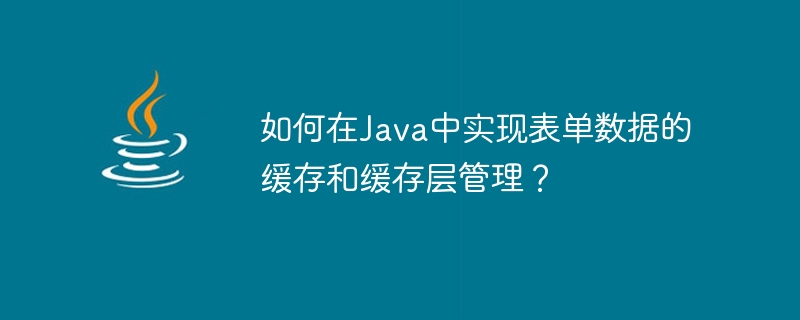

How to implement caching and cache layer management of form data in Java?
Introduction:
In web development, caching of form data and cache layer management are common requirements, which can improve website performance and user experience. This article will introduce how to implement caching and cache layer management of form data in Java, and provide code examples.
1. Caching of form data
The following is a sample code for using Guava Cache to cache form data:
import com.google.common.cache.Cache;
import com.google.common.cache.CacheBuilder;
public class FormCache {
private static Cache<String, FormData> cache = CacheBuilder.newBuilder()
.maximumSize(1000) // 设置缓存的最大容量
.build();
public static void put(String key, FormData data) {
cache.put(key, data);
}
public static FormData get(String key) {
return cache.getIfPresent(key);
}
}2. Cache layer management
The following is a sample code that uses enumeration classes to implement cache layer management:
public enum CacheLayerManager {
INSTANCE;
private Cache<String, FormData> cache;
private CacheLayerManager() {
cache = CacheBuilder.newBuilder()
.maximumSize(1000)
.build();
}
public void put(String key, FormData data) {
cache.put(key, data);
}
public FormData get(String key) {
return cache.getIfPresent(key);
}
}The following is a sample code for adding a scheduled task to clean the cache:
public class CacheLayerManager {
private static Cache<String, FormData> cache = CacheBuilder.newBuilder()
.maximumSize(1000)
.expireAfterWrite(30, TimeUnit.MINUTES) // 设置缓存的存活时间30分钟
.build();
static {
// 定时清理缓存
ScheduledExecutorService executorService = Executors.newSingleThreadScheduledExecutor();
executorService.scheduleAtFixedRate(new Runnable() {
@Override
public void run() {
cache.cleanUp();
}
}, 0, 1, TimeUnit.HOURS); // 每小时清理一次缓存
}
public static void put(String key, FormData data) {
cache.put(key, data);
}
public static FormData get(String key) {
return cache.getIfPresent(key);
}
}Summary:
In Java, it is a common method to implement caching and cache layer management of form data. Optimization strategies can improve website performance and user experience. This article introduces the use of Java's caching framework to cache form data, and provides sample code for using Guava Cache and enumeration classes to implement cache layer management. In actual applications, caching strategies can be adjusted and configured according to specific business needs to achieve better performance and user experience.
The above is the detailed content of How to implement caching and cache layer management of form data in Java?. For more information, please follow other related articles on the PHP Chinese website!
 What drawing software are there?
What drawing software are there?
 Recommended order for learning c++ and c language
Recommended order for learning c++ and c language
 How to withdraw money on WeChat without handling fees
How to withdraw money on WeChat without handling fees
 The performance of microcomputers mainly depends on
The performance of microcomputers mainly depends on
 How to use jsp programming software
How to use jsp programming software
 The Metaverse recognizes the top ten potential coins
The Metaverse recognizes the top ten potential coins
 How to delete a folder in linux
How to delete a folder in linux
 What to do if 302 found
What to do if 302 found
 what is ed
what is ed




